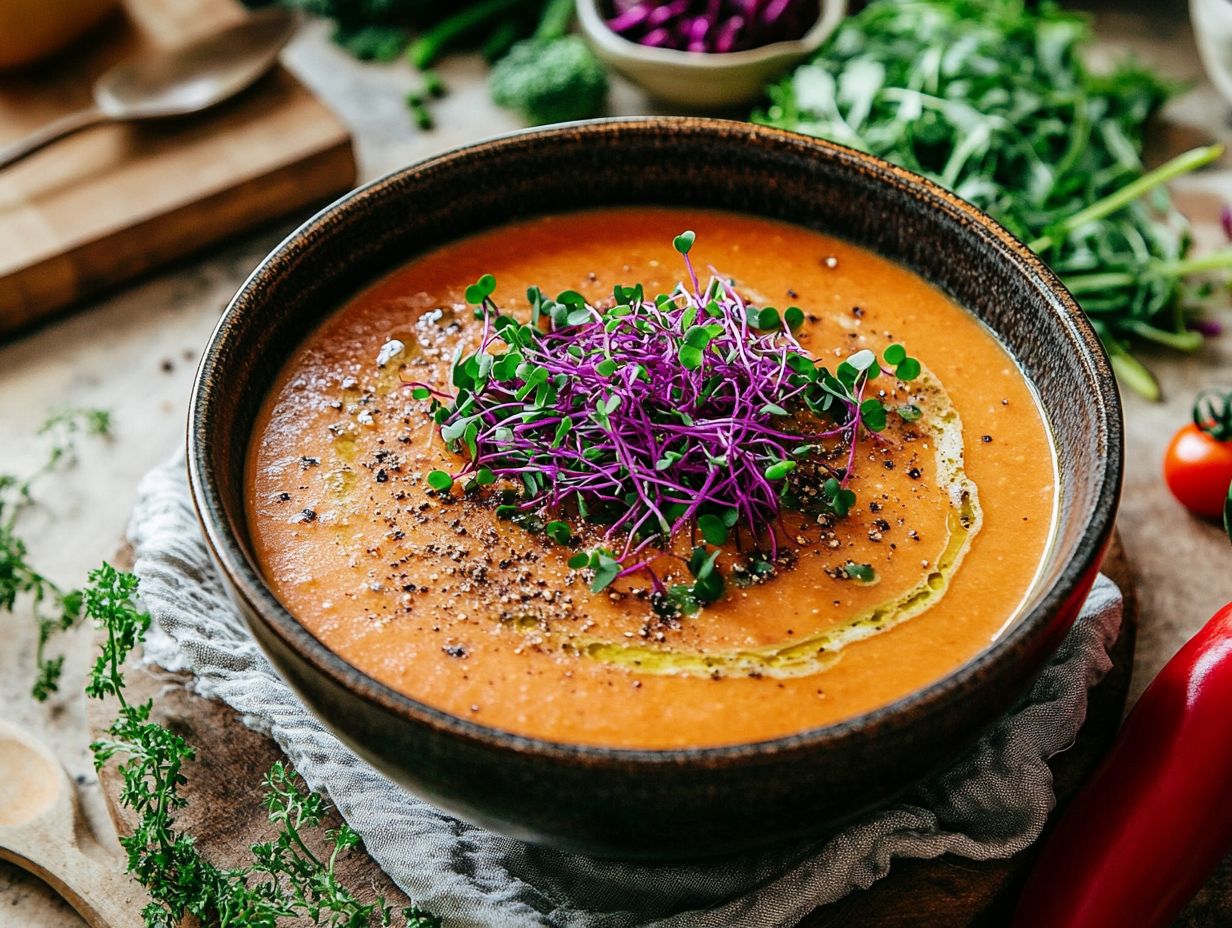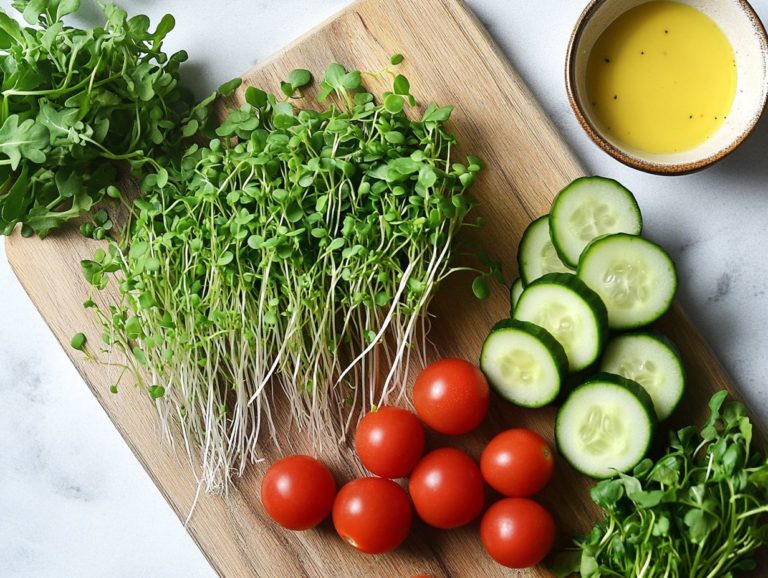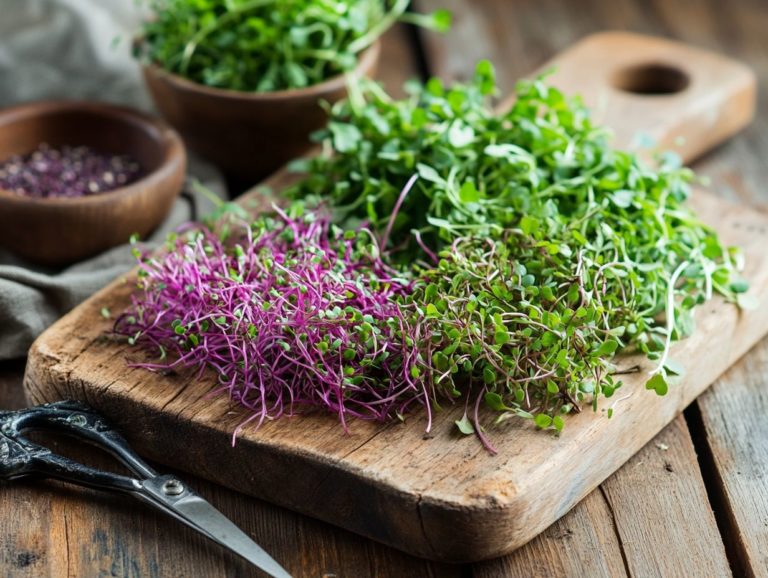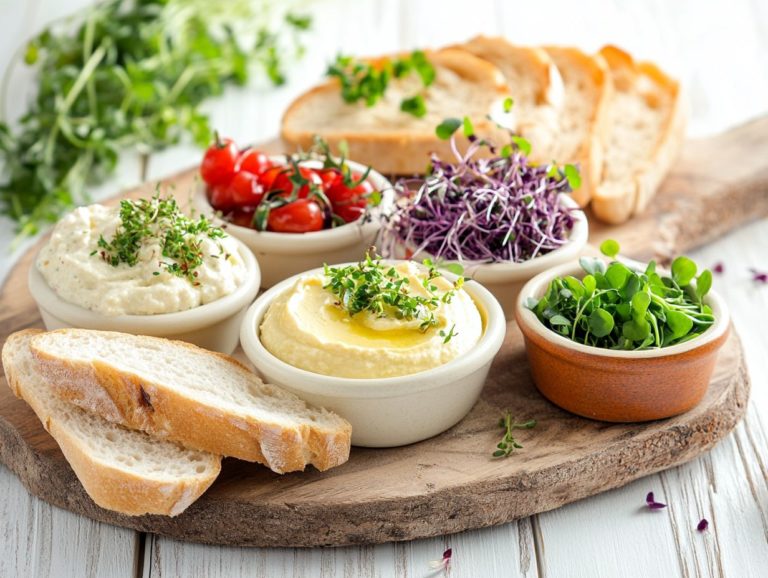51. How to Use Microgreens for Flavorful Soups
Microgreens, a variety of nutrient-dense greens, are tiny, nutrient-packed plants that can elevate your soups, salads, and sandwiches to an entirely new level. Get ready to discover how to pick the perfect microgreens and seamlessly incorporate them into both hot and cold soups. Essential tips on storing these vibrant greens to keep them fresh will also be at your fingertips.
Dive in today and transform your soup game!
Contents
- Key Takeaways:
- Benefits of Using Microgreens in Soups
- Enhancing Flavor and Texture
- Choosing the Right Microgreens for Soups
- Flavor Profiles and Complementary Ingredients
- How to Prepare Microgreens for Soups
- Washing and Preparing Microgreens
- Incorporating Microgreens into Soups
- Tips for Storing Microgreens and Other Fresh Ingredients
- Frequently Asked Questions
Key Takeaways:

What are Microgreens?
Microgreens are young edible plants harvested just after the first true leaves develop. They re bursting with nutrients, flavors, and health benefits.
These greens make a stellar addition to a variety of dishes, including salads, sandwiches, tacos, and burritos. Packed with vitamins, minerals, and antioxidants, microgreens have become incredibly popular among health-conscious food enthusiasts and chefs alike.
The diverse range of flavors from the sweet and tender notes of pea shoots to the spicy kick of radish greens turns them into versatile ingredients that enhance both the taste and visual appeal of many dishes.
By incorporating these nutrient-dense greens into your everyday meals, you can easily elevate your intake of essential nutrients, making your salads more exciting and your sandwiches infinitely more satisfying.
Benefits of Using Microgreens in Soups
Incorporating microgreens into your soups enhances their nutritional profile and elevates the overall flavor and presentation, transforming each bowl into a delightful cooking experience.
These petite greens, brimming with vitamins and minerals, are a nutritious addition that appeals to both health-conscious individuals and passionate food lovers alike.
Nutritional Benefits
Microgreens are a powerhouse of nutrition, often packing more vitamins and minerals than their fully-grown counterparts. This makes them the perfect addition to your soups, elevating both their health benefits and flavor.
These tiny greens boast a remarkable richness in antioxidants and essential vitamins A, C, E, and K, along with crucial minerals that support your overall health and well-being.
Recent studies have revealed that varieties such as radish, mustard, and beet microgreens offer a significant boost of polyphenols, celebrated for their ability to enhance heart health and reduce inflammation. Their vibrant colors aren’t just for show; they signal a treasure trove of phytochemicals that can improve your immune function and digestive health.
By incorporating these greens into your soups, you’re not just enhancing the taste; you’re also fortifying your meals with an extra layer of nutrition. This approach is particularly appealing to those who are health-conscious and eager to maximize the health benefits of their dietary choices.
Enhancing Flavor and Texture
The unique flavors and textures of microgreens can significantly elevate the taste of your soups. They add layers of complexity that are both appealing and satisfying. Whether you’re drawn to the peppery kick of mustard greens or the subtle sweetness of pea shoots, these tiny garnishes can transform a simple bowl of soup into a fancy experience.
By selecting microgreens that complement or contrast traditional soup ingredients, you can create an enticing medley of tastes. For instance, the bright freshness of arugula microgreens balances beautifully with rich, creamy bases. Meanwhile, the earthy notes of beet greens add depth to vegetable broths. To learn more about these nutritious additions, check out this guide on How to Incorporate Microgreens into Your Diet.
Try blending them into soups made smooth by blending for an exciting flavor boost. You can also artfully sprinkle them on top just before serving for an eye-catching presentation. This method not only enhances the nutritional profile but also invites diners to appreciate the intricate flavors and textures.
Choosing the Right Microgreens for Soups

Selecting the perfect microgreens for your soups is crucial for crafting a dish that is balanced and harmonious. Each variety brings its own unique flavor profile and texture, capable of complementing or enhancing the ingredients.
By understanding the distinct characteristics of microgreens like cilantro, mustard, and pea shoots, you can make informed choices for your culinary creations.
Flavor Profiles and Complementary Ingredients
Understanding the distinct flavor profiles of microgreens, such as the zesty bite of radish greens or the delicate sweetness of baby kale, can elevate your cooking. By choosing complementary ingredients, you can maximize the overall taste of your soups and transform an ordinary dish into a flavor-packed masterpiece.
For example, pairing the peppery notes of arugula with a creamy potato base not only balances but also elevates the entire dish. Alternatively, a sprinkle of sunflower shoots introduces delightful nutty undertones to a hearty vegetable broth.
To showcase these flavors, think about gently sautéing the microgreens in olive oil or lightly steaming them before adding them to your soup. Each microgreen offers unique characteristics, so it’s essential to consider their taste and texture for a well-rounded culinary experience. For more insights, explore microgreen varieties: how to maximize flavor.
How to Prepare Microgreens for Soups
Preparing microgreens for soups is a straightforward yet crucial step. This process helps these delicate greens retain their freshness and flavor during cooking.
By washing, trimming, and incorporating them thoughtfully, you can elevate both the taste and presentation of your favorite soup recipes.
Washing and Preparing Microgreens
Washing and preparing microgreens with care is essential for removing contaminants. This keeps them fresh and vibrant, ready to enhance your soups and salads. A gentle rinse followed by quick drying preserves their delicate texture and enhances their flavor.
- Start by soaking the microgreens in a bowl of cold water. This allows dirt or grit to settle at the bottom. Gently swishing them around helps dislodge debris without bruising the tender leaves.
- Once rinsed, pat them dry with a clean kitchen towel or use a salad spinner to eliminate excess moisture. This meticulous preparation maximizes their nutritional benefits and ensures they seamlessly integrate into your culinary creations.
When you’re ready to incorporate microgreens into your soups, add them just before serving. This maintains their vibrant color and crisp texture, enhancing both the visual appeal and the overall taste of your dish. Additionally, you might consider exploring ways to enhance flavor in microgreens for an even more delicious experience.
Incorporating Microgreens into Soups
Incorporating microgreens into your soups offers a sophisticated approach to elevate flavor and visual appeal, while also boosting the nutritional content of your dish. These vibrant greens serve as an exquisite garnish or can even be a primary ingredient.
Whether you stir them into a steaming broth or delicately sprinkle them over a chilled soup, microgreens have the incredible ability to transform your culinary creations into something truly exceptional.
Don t wait start transforming your soups with vibrant microgreens today!
Adding Microgreens to Hot and Cold Soups

When you re adding microgreens to hot soups, think about incorporating them just before serving. This technique preserves their vibrant color and delicate flavor.
For cold soups, feel free to mix them in thoroughly for a refreshing twist. This versatility opens up creative avenues to elevate your soups, whether you prefer them comforting and warm or light and chilled.
Timing is everything when it comes to capturing the essence of microgreens. For hot soups, gently sprinkle them on top as a final garnish. This not only maintains their crispness but also creates a delightful contrast with the warmth of the dish.
Imagine a bowl of creamy tomato bisque topped with vibrant basil microgreens talk about a pop of color and a burst of fresh flavor!
On the flip side, when you re working with cold soups like gazpacho, blending in a hearty handful of sunflower microgreens transforms it into a nutritious, green-packed delight. Consider exploring combinations such as carrot ginger soup adorned with radish microgreens or classic cucumber soup enriched with pea shoots.
These pairings will surely inspire your culinary creations.
Tips for Storing Microgreens and Other Fresh Ingredients
Proper storage of microgreens is essential for preserving their freshness and flavor. This ensures they continue to be a nutritious enhancement to your meals for as long as possible.
Follow these simple guidelines to savor the benefits of these vibrant greens in your cooking for days ahead.
Smart Storage Tips
The secret to keeping your microgreens fresh lies in adopting the right storage techniques. By using breathable containers and maintaining optimal humidity levels, you preserve their vibrant color and nutritional benefits, ensuring you can savor their flavors in soups and various dishes.
Choosing the right storage container is essential. Options like perforated plastic bags or ventilated clamshells promote airflow while minimizing moisture buildup.
For leafy varieties such as arugula or radish microgreens, place a damp paper towel in the container to help regulate humidity. This keeps them crisp without turning soggy.
Conversely, smaller shoots like pea tendrils thrive in a slightly more humid environment. A sealed container with a light misting of water can enhance their longevity.
Master these specific techniques to effectively extend the shelf life of your microgreens, ensuring they remain fresh and flavorful, ready to elevate any meal you prepare.
Final Thoughts and Recommendations
Incorporating microgreens into your soups is an exquisite way to elevate nutritional value and infuse vibrant flavors. It also enhances the presentation of your meals.
By carefully selecting the right varieties and employing proper preparation and storage techniques, you can maximize the potential of these tiny greens in your culinary creations.
Try adding them to salads, tacos, or as a garnish for your drinks today!
These nutrient-dense additions deliver significant health benefits while introducing exciting textures and colors. They can transform a simple soup into a culinary masterpiece.
When choosing microgreens, opt for robust varieties like pea shoots or radish greens, which maintain their flavor beautifully during cooking. Wash them thoroughly and consider adding them toward the end of the cooking process to preserve their delicate taste and nutrients.
For optimal storage, keep your microgreens in a breathable container in the fridge. This ensures they remain fresh.
This encourages adventurous cooks like you to experiment with various microgreens in your favorite recipes, allowing you to discover unique flavor profiles you never knew existed.
Frequently Asked Questions
What exactly are microgreens?

Microgreens are young plants that are harvested just a few weeks after sprouting. They are packed with nutrients and have a concentrated flavor, making them perfect for adding to soups.
Join the microgreens trend and share your favorite combinations with us!
Why should I use microgreens in my soups?
Microgreens add a burst of flavor to soups. They provide a variety of vitamins and minerals and enhance texture and visual appeal.
How do I choose the right microgreens for my soup?
The right microgreens depend on the flavor you want. For hearty soups, use peppery microgreens like arugula or radish.
For lighter soups, opt for delicate microgreens like pea shoots or basil.
When should I add microgreens to my soup?
Add microgreens just before serving. This keeps their texture intact and prevents them from losing flavor and nutrients.
Can I use microgreens in any type of soup?
Yes, you can use microgreens in many soups, from creamy purees to broths. Select microgreens that match the soup’s flavor profile.
Are there any other ways to use microgreens in soups?
Besides garnishing, you can also mix microgreens into the soup base for extra flavor and nutrition. Puree them with broth or water and mix them into your soup.






